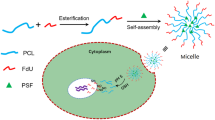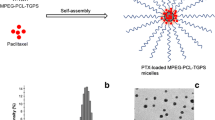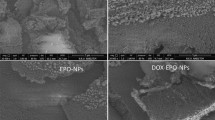Abstract
Purpose
To develop a multifunctional nanoparticle system carrying a combination of pro-apoptotic drug, NCL-240, TRAIL [tumor necrosis factor-α (TNF-α)-related apoptosis-inducing ligand] and anti-survivin siRNA and to test the combination preparation for anti-cancer effects in different cancer cells.
Methods
Polyethylene glycol-phosphoethanolamine (PEG-PE) – based polymeric micelles were prepared carrying NCL-240. These micelles were used in combination with TRAIL-conjugated micelles and anti-survivin siRNA-S-S-PE containing micelles. All the micelles were characterized for size, zeta potential, and drug encapsulation efficiency. Different cancer cells were used to study the cytotoxicity potential of the individual as well as the combination formulations. Other cell based assays included cellular association studies of transferrin-targeted NCL-240 micelles and study of cellular survivin protein downregulation by anti-survivin siRNA-S-S-PE containing micelles.
Results
NCL-240 micelles and the combination NCL-240/TRAIL micelles significantly increased cytotoxicity in the resistant strains of SKOV-3, MCF-7 and A549 as compared to free drugs or single drug formulations. The NCL-240/TRAIL micelles were also more effective in NCI/ADR-RES cancer cell spheroids. Anti-survivin siRNA micelles alone displayed a dose-dependent reduction in survivin protein levels in A2780 cells. Treatment with NCL-240/TRAIL after pre-incubation with anti-survivin siRNA inhibited cancer cell proliferation. Additionally, a single multifunctional system composed of NCL-240/TRAIL/siRNA PM also had significant cytotoxic effects in vitro in multiple cell lines.
Conclusion
These results demonstrate the efficacy of a combination of small-molecule PI3K inhibitors, TRAIL, and siRNA delivered by micellar preparations in multiple cancer cell lines.








Similar content being viewed by others
Abbreviations
- c-FLIP:
-
Cellular FLICE (FADD-like IL-1β-converting enzyme)-inhibitory protein
- EPR:
-
Enhanced permeability and retention
- IAP:
-
Inhibitor of apoptosis
- MDR:
-
Multi-drug resistant
- mNCL-240:
-
NCL-240 – loaded polymeric micelles
- mNCL-240/TRAIL:
-
NCL-240 – loaded, TRAIL-conjugated polymeric micelles
- mSurvivin:
-
Anti-survivin siRNA-S-S-PE mixed micelles
- mTf:
-
Transferrin – targeted polymeric micelles
- PDK1:
-
3-phosphoinositide-dependent kinase-1
- PE:
-
Phosphatidylethanolamine
- PEG:
-
Polyethylene glycol
- PH:
-
Pleckstrin-homology
- PI3K:
-
Phosphoinositide 3-kinase
- PIP2 :
-
Phosphatidylinositol-3,4-diphosphate
- PIP3 :
-
Phosphatidylinositol-3,4,5-triphosphate
- PKB/Akt:
-
Protein kinase B
- PM:
-
Polymeric micelles
- pNP:
-
p-nitrophenylcarbonyl
- PTEN:
-
Phosphatase and tensin homologous protein
- siRNA:
-
Small interfering RNA
- siRNA-S-S-PE PM:
-
siRNA-S-S-PE – containing mixed micelles
- Tf:
-
Transferrin
- TRAIL:
-
Tumor necrosis factor-α (TNF-α)-related apoptosis-inducing ligand
References
Riehle RD, Cornea S, Degterev A. Role of phosphatidylinositol 3,4,5-trisphosphate in cell signaling. Adv Exp Med Biol. 2013;991:105–39.
Maehama T, Dixon JE. PTEN: a tumour suppressor that functions as a phospholipid phosphatase. Trends Cell Biol. 1999;9(4):125–8.
Vivanco I, Sawyers CL. The phosphatidylinositol 3-Kinase AKT pathway in human cancer. Nat Rev Cancer. 2002;2(7):489–501.
Workman P, Clarke PA, Raynaud FI, van Montfort RL. Drugging the PI3 kinome: from chemical tools to drugs in the clinic. Cancer Res. 2010;70(6):2146–57.
Hixon ML, Paccagnella L, Millham R, Perez-Olle R, Gualberto A. Development of inhibitors of the IGF-IR/PI3K/Akt/mTOR pathway. Rev Recent Clin Trials. 2010;5(3):189–208.
McNamara CR, Degterev A. Small-molecule inhibitors of the PI3K signaling network. Future Med Chem. 2011;3(5):549–65.
Miao B, Skidan I, Yang J, Lugovskoy A, Reibarkh M, Long K, et al. Small molecule inhibition of phosphatidylinositol-3,4,5-triphosphate (PIP3) binding to pleckstrin homology domains. Proc Natl Acad Sci U S A. 2010;107(46):20126–31.
Skidan I, Miao B, Thekkedath RV, Dholakia P, Degterev A, Torchilin V. In vitro cytotoxicity of novel pro-apoptotic agent DM-PIT-1 in PEG-PE-based micelles alone and in combination with TRAIL. Drug Deliv. 2009;16(1):45–51.
Riehle RD, Cornea S, Degterev A, Torchilin V. Micellar formulations of pro-apoptotic DM-PIT-1 analogs and TRAIL in vitro and in vivo. Drug Deliv. 2013;20(2):78–85.
Torchilin VP. Lipid-core micelles for targeted drug delivery. Current Drug Deliv. 2005;2(4):319–27.
Torchilin V. Tumor delivery of macromolecular drugs based on the EPR effect. Adv Drug Deliv Rev. 2011;63(3):131–5.
Torchilin VP, Lukyanov AN, Gao Z, Papahadjopoulos-Sternberg B. Immunomicelles: targeted pharmaceutical carriers for poorly soluble drugs. Proc Natl Acad Sci U S A. 2003;100(10):6039–44.
Torchilin VP, Levchenko TS, Lukyanov AN, Khaw BA, Klibanov AL, Rammohan R, et al. p-Nitrophenylcarbonyl-PEG-PE-liposomes: fast and simple attachment of specific ligands, including monoclonal antibodies, to distal ends of PEG chains via p-nitrophenylcarbonyl groups. Biochim Biophys Acta. 2001;1511(2):397–411.
Patel NR, Pattni BS, Abouzeid AH, Torchilin VP. Nanopreparations to overcome multidrug resistance in cancer. Adv Drug Deliv Rev. 2013;65(13–14):1748–62.
Salzano G, Riehle R, Navarro G, Perche F, De Rosa G, Torchilin VP. Polymeric micelles containing reversibly phospholipid-modified anti-survivin siRNA: a promising strategy to overcome drug resistance in cancer. Cancer Lett. 2014;343(2):224–31.
Torchilin VP. Multifunctional nanocarriers. Adv Drug Deliv Rev. 2012;64:302–15.
Johnstone RW, Frew AJ, Smyth MJ. The TRAIL apoptotic pathway in cancer onset, progression and therapy. Nat Rev Cancer. 2008;8(10):782–98.
Guseva NV, Rokhlin OW, Taghiyev AF, Cohen MB. Unique resistance of breast carcinoma cell line T47D to TRAIL but not anti-Fas is linked to p43cFLIP(L). Breast Cancer Res Treat. 2008;107(3):349–57.
Rodel F, Sprenger T, Kaina B, Liersch T, Rodel C, Fulda S, et al. Survivin as a prognostic/predictive marker and molecular target in cancer therapy. Curr Med Chem. 2012;19(22):3679–88.
Altieri DC. Survivin, cancer networks and pathway-directed drug discovery. Nat Rev Cancer. 2008;8(1):61–70.
Musacchio T, Vaze O, D’Souza G, Torchilin VP. Effective stabilization and delivery of siRNA: reversible siRNA-phospholipid conjugate in nanosized mixed polymeric micelles. Bioconjug Chem. 2010;21(8):1530–6.
Schafer FQ, Buettner GR. Redox environment of the cell as viewed through the redox state of the glutathione disulfide/glutathione couple. Free Radic Biol Med. 2001;30(11):1191–212.
Sawant RR, Jhaveri AM, Koshkaryev A, Zhu L, Qureshi F, Torchilin VP. Targeted transferrin-modified polymeric micelles: enhanced efficacy in vitro and in vivo in ovarian carcinoma. Mol Pharm. 2014;11(2):375–81.
Trabulo S, Cardoso AM, Santos-Ferreira T, Cardoso AL, Simoes S. Pedroso de Lima MC. Survivin silencing as a promising strategy to enhance the sensitivity of cancer cells to chemotherapeutic agents. Mol Pharm. 2011;8(4):1120–31.
Perche F, Patel NR, Torchilin VP. Accumulation and toxicity of antibody-targeted doxorubicin-loaded PEG-PE micelles in ovarian cancer cell spheroid model. J Contr Release: Off J Control Release Soc. 2012;164(1):95–102.
Sawant RR, Torchilin VP. Design and synthesis of novel functional lipid-based bioconjugates for drug delivery and other applications. Methods Mol Biol. 2011;751:357–78.
Sawant RR, Torchilin VP. Multifunctionality of lipid-core micelles for drug delivery and tumour targeting. Mol Membr Biol. 2010;27(7):232–46.
Reulen SW, Merkx M. Exchange kinetics of protein-functionalized micelles and liposomes studied by Forster resonance energy transfer. Bioconjug Chem. 2010;21(5):860–6.
Salzano G, Navarro G, Trivedi MS, De Rosa G, Torchilin VP. Multifunctional polymeric micelles Co-loaded with anti-survivin siRNA and paclitaxel overcome drug resistance in an animal model of ovarian cancer. Mol Cancer Ther. 2015;14(4):1075–84.
Calzolari A, Oliviero I, Deaglio S, Mariani G, Biffoni M, Sposi NM, et al. Transferrin receptor 2 is frequently expressed in human cancer cell lines. Blood Cells Mol Dis. 2007;39(1):82–91.
Lamendola DE, Duan Z, Yusuf RZ, Seiden MV. Molecular description of evolving paclitaxel resistance in the SKOV-3 human ovarian carcinoma cell line. Cancer Res. 2003;63(9):2200–5.
Patel NR, Rathi A, Mongayt D, Torchilin VP. Reversal of multidrug resistance by co-delivery of tariquidar (XR9576) and paclitaxel using long-circulating liposomes. Int J Pharm. 2011;416(1):296–9.
He C, Rong R, Liu J, Wan J, Zhou K, Kang JX. Effects of Coptis extract combined with chemotherapeutic agents on ROS production, multidrug resistance, and cell growth in A549 human lung cancer cells. Chin Med. 2012;7(1):11.
Donmez Y, Akhmetova L, Iseri OD, Kars MD, Gunduz U. Effect of MDR modulators verapamil and promethazine on gene expression levels of MDR1 and MRP1 in doxorubicin-resistant MCF-7 cells. Cancer Chemother Pharmacol. 2011;67(4):823–8.
Kim K, Fisher MJ, Xu SQ. el-Deiry WS. Molecular determinants of response to TRAIL in killing of normal and cancer cells. Clin Cancer Res: Off J Am Assoc Cancer Res. 2000;6(2):335–46.
Sanlioglu AD, Dirice E, Aydin C, Erin N, Koksoy S, Sanlioglu S. Surface TRAIL decoy receptor-4 expression is correlated with TRAIL resistance in MCF7 breast cancer cells. BMC Cancer. 2005;5:54.
Taylor JR, Lehmann BD, Chappell WH, Abrams SL, Steelman LS, McCubrey JA. Cooperative effects of Akt-1 and Raf-1 on the induction of cellular senescence in doxorubicin or tamoxifen treated breast cancer cells. Oncotarget. 2011;2(8):610–26.
Lee SM, Lee CT, Kim YW, Han SK, Shim YS, Yoo CG. Hypoxia confers protection against apoptosis via PI3K/Akt and ERK pathways in lung cancer cells. Cancer Lett. 2006;242(2):231–8.
Foster H, Coley HM, Goumenou A, Pados G, Harvey A, Karteris E. Differential expression of mTOR signalling components in drug resistance in ovarian cancer. Anticancer Res. 2010;30(9):3529–34.
Bao R, Connolly DC, Murphy M, Green J, Weinstein JK, Pisarcik DA, et al. Activation of cancer-specific gene expression by the survivin promoter. J Natl Cancer Inst. 2002;94(7):522–8.
ACKNOWLEDGMENTS AND DISCLOSURES
NIH/NCI grant U54CA151881 to V.T.
Author information
Authors and Affiliations
Corresponding author
Additional information
Robert Riehle and Bhushan Pattni contributed equally to this work.
Rights and permissions
About this article
Cite this article
Riehle, R., Pattni, B., Jhaveri, A. et al. Combination Nanopreparations of a Novel Proapoptotic Drug – NCL-240, TRAIL and siRNA. Pharm Res 33, 1587–1601 (2016). https://doi.org/10.1007/s11095-016-1899-z
Received:
Accepted:
Published:
Issue Date:
DOI: https://doi.org/10.1007/s11095-016-1899-z




